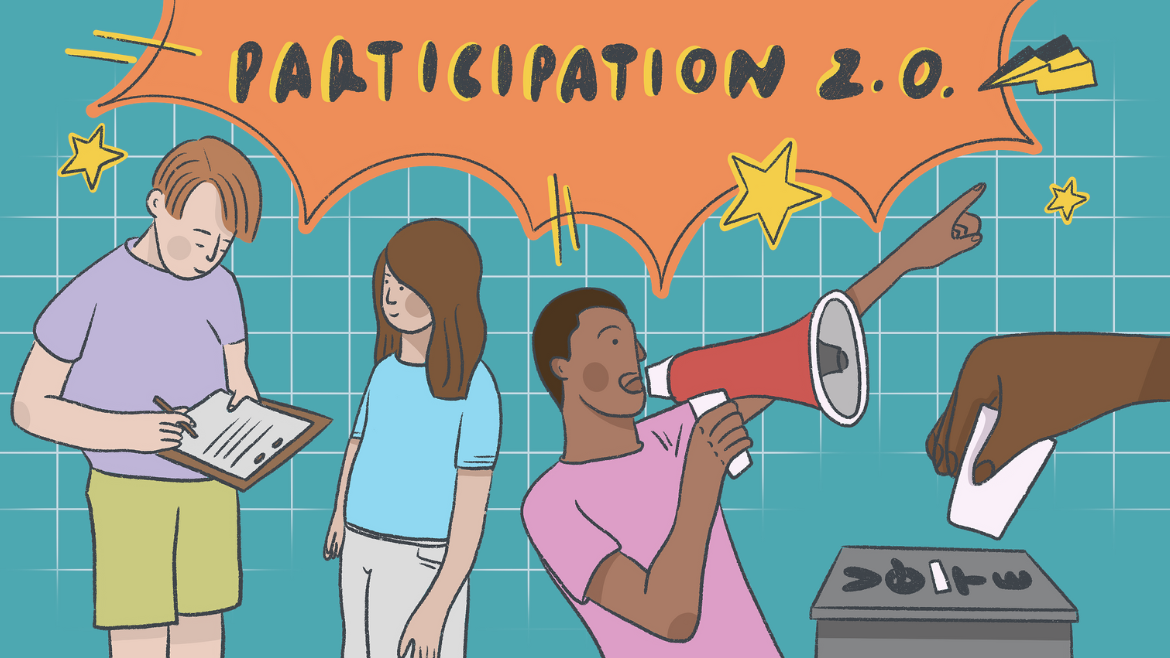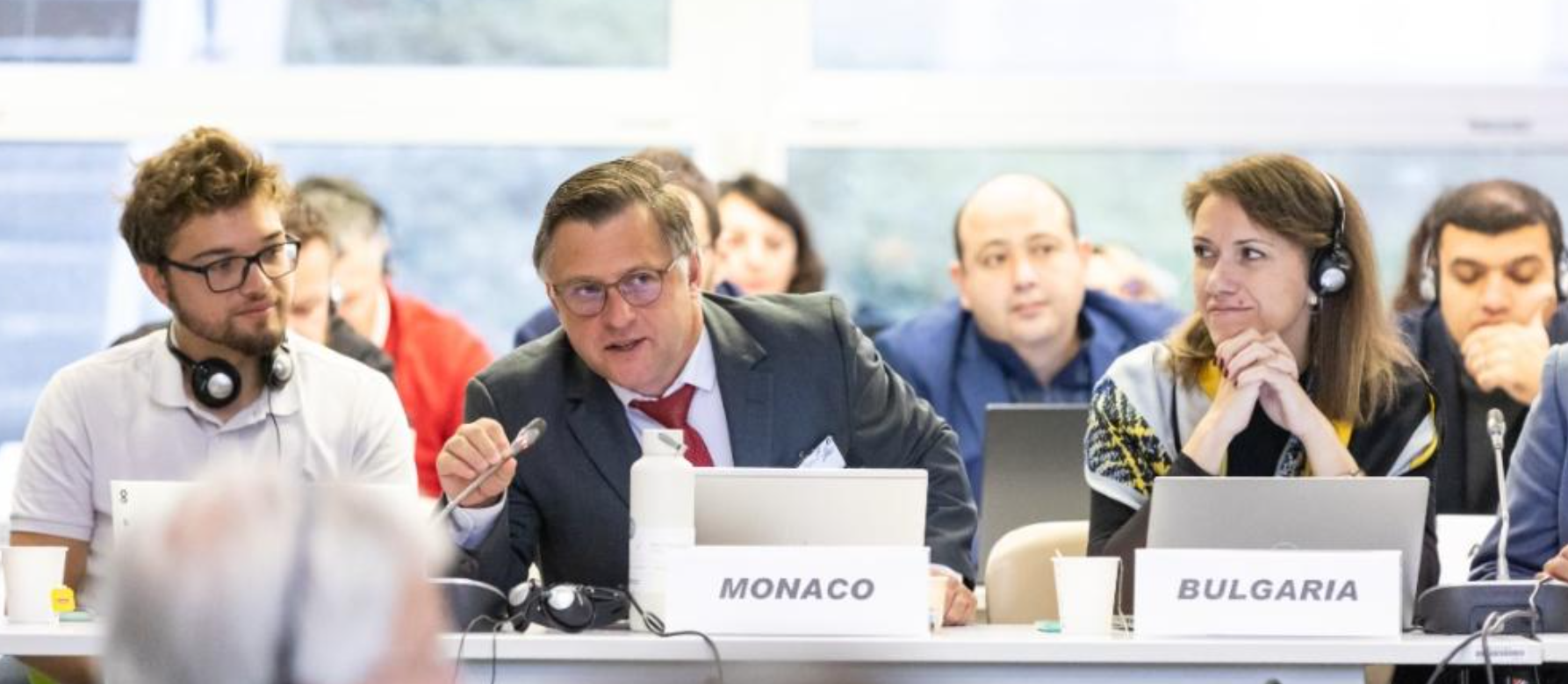
Illustration by Daniela Nunes
Youth participation 2.0: new guidelines to move forward
by Gianluca Rossino
Young people’s participation is a constantly developing phenomenon, with many different factors to consider, depending on what we care to understand, monitor or promote ourselves. While uncertainties are many, what is commonly accepted is that youth participation in public life is, unfortunately, not a universal granted right. In fact, the means available to young people often differ from place to place, the support from the public sector is at times encouraging, other times non-existent. Even the spaces dedicated to young people, as physical places to meet and connect with each other or as digital environments that can be considered safe and accessible, are lacking. On top of that, the impact that the Covid-19 pandemic played in this context is still not fully understood.
Even myself, as a young person, before considering any professional role I have, I am often uncertain about what rights I have to influence certain processes, the purpose and impact of what I can do in society. Despite striving to advocate certain initiatives, when it comes to innovative youth policies, I often meet a brick wall when engaging with those holding the power to make decisions, getting nowhere beyond where I started.
Nevertheless, we do have valuable resources and opportunities from the European context to support us in these efforts. From training processes to examples of traditional forms of participation, to innovative methods and digital solutions to foster the engagement of young people in public life, we can find a huge array of policy documents, definitions, ideas and trends to explore and reflect on. If anything, this abundance of resources often suffers from a lack of wider plans or strategies designed to increase and improve the quality of youth participation, especially for those youth workers, elected officials and youth leaders that lack a compass to help them out. To face this challenge, and to provide better information to practitioners and policy makers, the Joint Council on Youth of the Council of Europe (the co-management body of the Organisation’s youth sector) created in 2023 a set of 30 guidelines across five thematic areas. These guidelines are meant to serve as a reference to member states to enhance youth participation at local, regional and national levels while helping youth organisations to access relevant Council of Europe policies. The guidelines also serve as a testament, even for public institutions, of the pressing need to encourage and support young people’s participation, which should not be limited to simply asking their opinions. Their aim is to provide clearer guidance and examples, for instance by exploring the roles played by young people and youth activists in promoting and fostering youth participation, and by reflecting on policies and tools member states should put in place to facilitate young people’s meaningful contribution to public life.
A drafting group, composed of two members of the European Steering Committee for Youth (CDEJ), two members of the Advisory Council on Youth (CCJ), one representative of the European Youth Forum and the active contributions of half a dozen young people and youth workers/experts in the field, developed the guidelines in a participatory process that spanned six months. I had the privilege to co-chair this process with my colleague representing Bulgaria in the Joint Council on Youth, supported by the very valuable work carried out by the Youth Department secretariat.

The final document includes 30 guidelines, spread across five thematic areas:
- recognition of participation beyond institutional politics;
- promotion of participation in political institutions;
- translation of youth voices and interests into public policies;
- recognition of the opportunities (and dangers) of information and communications technology;
- the importance of civic spaces and youth work in securing youth participation.
You will find for each thematic area a section devoted to evidence and key takeaways (such as statements and conclusions emerging from existing studies), a few key principles (to actively promote or encourage a certain initiative) and practices from the field that were mapped over the course of summer 2023, with the contribution of many policy makers, practitioners and young people from across Europe. Overall, the structure of this document is meant to offer guidance to relevant stakeholders on how to curb problems related to youth participation and provide potential solutions for addressing the problem in practice.
 How are these guidelines relevant?
How are these guidelines relevant?
Having introduced the framework under which the guidelines were developed, we can see how they can provide useful context and references for new policies, concrete measures that can be introduced and adapted to different realities, and examples of initiatives that might be replicated or at least consulted for inspiration. It is important to underline that, when taking stock of positive examples related to youth participation, the document primarily recognises the efforts made by different institutions and actors to facilitate youth participation, as this is a policy document that is directly addressed to member states, local and regional authorities and practitioners.
Let’s now look at them in more detail. To provide better context and understanding, I will now introduce a couple of models and cases presented in the different sections, and see how they can relate to the ever-changing landscape of youth participation, such as the complexity of youth transitions (even more so after Covid-19) and current priority issues for young people, such as inequality, climate change, youth unemployment, mental health and well-being (Soler-i-Martí 2014; Deželan 2022).
Under point 4.1: “How youth participation has evolved”, we can find following guideline:
Provide funding to invest in research initiatives aimed at understanding and analysing new forms of youth participation.
To give you a practical idea, you can follow this link to discover the concept of a participatory district budget that is being adopted by Ghent, 2024 European Youth Capital, a city that already allocates 7% of its annual budget to youth policies.
If we look at point 4.2: “Negative effects of lower youth participation in institutional politics”, one of the proposed guidelines is as follow:
Introduce and promote e-voting and other forms of electoral facilitation that are beneficial to young people.
As an example, you can explore a short study that analyses the impact of lowering the voting age to 16 in Austria, 10 years after the measure was first introduced.
Finally, in the spirit of the 2024 European elections, we can explore point 4.4: “The impact of the internet and social media on youth participation” by focusing on guideline number 2:
Consider targeted strategies to use effectively the networked dimension of young people’s participation in social issues.
To stay on point, in 2019 the European Parliament and the European Youth Card Association (EYCA) collaborated on the initiative “#IVoteIWin Campaign” to inform and mobilise young people to cast their votes in the last European elections.

What are the risks/challenges ahead of us?
Guidelines as such are not legally binding documents, and they cannot be considered of universal relevance on their own. The word “guidelines” itself suggests that they need to be adapted and integrated into different contexts and practices, to positively guide policy makers and practitioners in the right direction.
Another key point in my opinion is the timeline ahead of us. Despite the effort in the drafting process, we need to remember that the guidelines are based on two policy documents of the Council of Europe, the Revised European Charter on the Participation of Young People in Local and Regional Life (2003) and the Committee of Ministers Recommendation Rec(2006)14 on citizenship and participation of young people in public life. The Congress of Local and Regional Authorities has taken a decision to revise the charter, which has been welcomed by the sector as many processes, needs and means have changed in the last 20 years.
On top of that, once the two reference documents undergo a revision process, it would be indispensable to also update the guidelines based on the latest major developments from the youth field. Just to give a couple of examples, I am thinking about the importance of youth workers and their (deserved) further recognition in Europe as key educational references to stimulate youth participation at the grass-roots level. I also have in mind how artificial intelligence will quickly reshape the landscape of our lives, and that could also influence how political power, media literacy and civic engagement are perceived by different people and stakeholders. Along with that, we are seeing a new push in the direction of youth engagement mechanisms and models in multiple areas of the world. From local youth and children’s councils to advisory bodies at multiple levels, to sounding boards supporting the work of international institutions and co-management bodies that can take major responsibilities in defining programmes and policies. In short, these guidelines will need some integration over the years to stay relevant.
Moreover, when looking at different practices and examples compiled throughout the text, it is important to consider the context in which they were generated. Evidence and trends from other practices can only be useful if the context is provided. We should remember that it is basically never possible to simply copy effective practices and paste into other environments without significant revision. For that, these guidelines provide mostly recorded examples that improve youth participation.
 What could be the future for these guidelines?
What could be the future for these guidelines?
What I would like to see as an activist for democracy
Speaking as an individual, and an advocate of meaningful youth participation, I would really like to see more references in our daily lives to the good practices, examples and opportunities that are connected to youth participation. Just some of those are available in the guidelines, but they can be a good starting point if complemented by educational programmes starting in the early years at schools and in youth centres. In the years ahead, we will be on a mission to create a more present and shared feeling of belonging to our communities, and to empower new generations to play their part. Good practices and publications like these guidelines will be a resource as long as they are relevant for present challenges and opportunities, and may possibly have a long-standing impact if we dedicate effort to making use of them and adapting them to specific situations and needs. Only by doing that can we build momentum and change the course of worrying trends in Europe regarding political polarisation, extremist views, discriminatory beliefs and the progressive detachment of young people from politics and civic engagement.
What would be helpful to support and multiply the benefits of these guidelines?
Looking at the guidelines as a professional and with the experience gained when drafting them, I hope that these guidelines will be used as a tool by national governments, civil society organisations and local and regional authorities. With some creative thinking, they can become the basis for educational activities, they can inspire and reinforce local and national youth policy plans and strategies, and they can also be taken as a source of inspiration for youth organisations and informal groups to advocate better opportunities in the community they are part of.
As with any policy document, it can only give some hope and hopefully some inspiration.
I believe it is our professional duty to give actual meaning to these guidelines, something that otherwise would just be words on paper.
To reiterate the point I made when the guidelines were approved, I would again invite those youth representatives, civil servants and policy makers who are now part of the co-management system to make reference to these guidelines and consider them as an evolving tool that can be updated and improved over time. A valuable hand could be given by the future activities of the Education and Training Division of the Council of Europe’s Youth Department to make use of them with different groups and give them greater relevance.

 Further resources
Further resources
Official publication of the CMJ guidelines: https://rm.coe.int/youth-participation-2-0-/1680ae98c2.
Other articles: www.coe.int/en/web/youth/-/youth-participation-2.0;
www.coe.int/en/web/youth/-/youth-participation-2.0-joint-council-on-youth-cmj-calls-for-young-people-s-participation-in-decision-making-processes.
 References
References
Deželan T. (2022), “Covid-19 impact on youth participation and youth spaces”, Youth Partnership, Brussels, p. 15: https://pjp-eu.coe.int/documents/42128013/72351197/The+impact+of+the+covid19+pandemic+on+youth+spaces.pdf/9bfe2c91-6cc1-2fdf-4d3f-7197b350fd7d.
Soler-i-Martí R. (2014), “Youth political involvement update: measuring the role of cause-oriented political interest in young people’s activism”, Journal of Youth Studies, 18(3), 396-416.

Gianluca is a freelance project manager, facilitator and youth representative, with a strong interest in processes of youth engagement.


